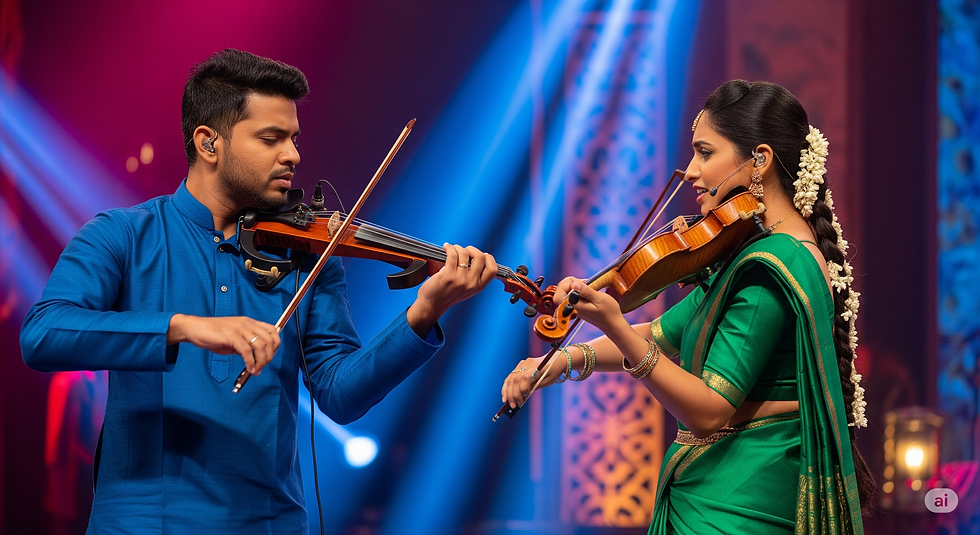"Your Bow's Secret Language: Mastering Speed and Pressure for Emotion"
- Sharanya naidu
- Jul 4
- 3 min read
As a string player, your bow isn't just a tool; it's the direct connection to your instrument's soul, allowing you to breathe life into every note. If you're learning a string instrument, understanding and mastering bow control and speed variations isn't just about technique—it's about finding your unique musical voice and captivating your audience.
Let's explore how these fundamental concepts can transform your playing from simply accurate to truly expressive.

Why Your Bow's Movement Shapes Everything
Imagine a singer who performs every line at the same volume and pace. Monotonous, right? The same applies to string instruments. Your bow's movement dictates:
Dynamics: Achieve anything from a whispering pianissimo to a powerful fortissimo by varying the pressure and speed of your bow.
Tone Color (Timbre): Different bow speeds and contact points on the string create a vast spectrum of sounds—from bright and vibrant to warm and mellow.
Articulation: Crisp, detached notes (staccato) or smooth, connected phrases (legato) come alive through precise bow control.
Phrasing and Emotion: Varying bow speed and pressure allows you to highlight key notes, build tension, release emotion, and shape the story the music tells.
The Essential Partnership: Bow Speed and Bow Pressure
While often discussed together, it's crucial to grasp the distinct roles of bow speed and bow pressure and how they work in tandem.
Bow Speed: This refers to how quickly your bow travels across the string.
Faster Bow Speed: Generally produces a louder, fuller sound (assuming consistent pressure). Use it for sustained notes, powerful passages, or to create urgency.
Slower Bow Speed: Creates a quieter, more delicate sound. It's essential for soft dynamics, intimate passages, or conveying calm and mystery.
Bow Pressure: This is the amount of weight you apply through your hand, primarily your index finger, onto the bow stick.
More Pressure: Increases the intensity and focus of the sound, making it brighter. Be careful: too much pressure without enough speed can lead to a harsh or choked sound.
Less Pressure: Results in a lighter, airier, and often more ethereal sound. Too little pressure can make your sound thin or wispy.
The Dynamic Duo: How They Intertwine
This is where the magic happens. It's not about choosing one over the other; it's about finding the perfect balance for the desired sound.
Loud and Full Sound: Combine high bow speed with sufficient bow pressure.
Soft and Delicate Sound: Use slow bow speed with light bow pressure.
Bright and Intense Sound: Opt for faster bow speed with slightly more concentrated pressure.
Warm and Mellow Sound: Employ moderate bow speed with balanced, even pressure.
Think of it this way: bow speed is the engine driving the sound, and bow pressure acts as the accelerator and brake, fine-tuning its character and nuance.
Practical Steps to Elevate Your Expressive Bowing
Isolate and Experiment:
Long Tones: Practice long, sustained notes. First, vary only your bow speed (keeping pressure consistent). Then, vary only your bow pressure (keeping speed consistent). Listen intently to the changes in sound.
Dynamic Drills: Take simple scales or melodies and practice them with extreme dynamic contrasts. Play a phrase mezzo forte, then repeat it pianissimo, then fortissimo.
Listen Actively:
Record yourself! This is one of the best ways to catch inconsistencies and hear how your bow choices translate into actual sound.
Listen to professionals. How do they shape a phrase? How do they use dynamics to convey emotion? Try to mimic what you hear.
Master Bow Divisions:
Play a four-beat note using a full bow, then half a bow, then a quarter bow. Notice how the sound changes even if the dynamic is similar. This precise control is vital for articulation.
Aim for Smoothness:
Unless a sudden effect is intended, strive for fluid, seamless transitions in your bow speed and pressure. Avoid jerky movements.
Connect with the Music's Emotion:
Before you even play, consider the emotional context of the piece. Is it joyful, sorrowful, triumphant? Let this understanding guide your bow choices and deepen your musical connection.
Be Patient and Persistent:
Developing nuanced bow control takes time, practice, and dedication. Don't get discouraged! Celebrate every small improvement and keep at it.
By consciously exploring and mastering the intricate dance between bow control and speed variations, you'll unlock a new dimension of expressive playing. Your instrument won't just be a collection of strings and wood; it will become a true extension of your artistic voice.
What's one new bow control technique you're excited to try in your next practice session?



Comments